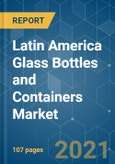The glass bottles and containers in Latin America was estimated at USD 5215.1 million in 2020, and is expected to reach USD 6731.97 million by 2026, witnessing growth at a projected CAGR of 4.4% over the forecast period 2021 - 2026. Strong economic growth among the middle-class of the region is likely to make it more attractive for the pharmaceutical investments in future, which is likely to grow the market.
Key Market Trends
Milk and other Dairy Products to Hold a Significant Share
Cosmetics sector to Drive the Market Growth
Competitive Landscape
The Latin America glass bottles and containers market is a fragmented market. Regional players and international vendors are competing for their market share, by attracting customers with prices and powerful competitive strategies, leading to moderate market competition. Key players are Vitro, Cattorini Hnos SA, Wheaton Brasil Group, etc. The recent developments in the market include-
Reasons to Purchase this report:
This product will be delivered within 2 business days.
- Growing demand from beverage industry is driving the market. According to the Argentina’s Secretary of Integral Policy on Drugs, the region consumes most alcohol per capita of any country. Similarly, in Brazil, consumption of alcohol between inhabitants is considerably high. Growing consumption of non-alcoholic beverages, such as milk and juices, are further expected to create a scope for glass bottles and containers market in the region.
- Recent innovation such as lightweight and effective recycling is driving the market. Newer production methods and recycle effect make it possible to manufacture more, particularly thin-walled and lightweight glass containers. The development of the Narrow Neck Press and Blow process has allowed for a significant reduction in the weight of glass bottles in Latin America.
- High competition from substitute products is restraining the market. Changes in consumer trend toward convenient and comfortable handling solutions are anticipated to drive the demand for flexible solutions. Incremental enhancements in plastic packaging solutions are posing a threat to the glass packaging market.
Key Market Trends
Milk and other Dairy Products to Hold a Significant Share
- Latin America's dairy market is one of the fastest growing markets in the world. While wider prosperity has helped shift demand from glass to rigid plastic and metal, demand for value added packaging like reusable glass is still high. Refillable glass bottles have long made beverages, like milk more affordable for consumers in this region.
- Amcor has developed ‘glass-look-a-like’ clear polyethylene terephthalate (PET) bottles to address the growing demand for transparent dairy packaging in Latin America. To protect the contents, the container includes a 38-mm finish and an ultraviolet (UV) blocker.
- The production of fluid milk is increasing in Mexico. According to the US Department of Agriculture, in Mexico, production of fluid milk increased by 12% during 2010-2019. Glass bottles are mainly used for packaging of milk as it preserve the flavor of dairy products, such as milk, much longer than other types of packaging. This is because glass is less likely to allow contents to mix with air or other possible chemicals.
- Large number of firms in Mexico has increased the shelf-life of pasteurized fresh milk from 7 days to 15 days. This is achieved by incorporating silver-based microparticles with antimicrobial, bactericidal, and self-sterilizing properties into the plastic bottles that are used for packaging milk.
Cosmetics sector to Drive the Market Growth
- The cosmetic packaging segment, includes skincare products, hair care products, and perfumes. In latin america, there is an increasing incorporation of glass packaging in the cosmetic industry for high-end luxury products. This is gaining traction, as glass renders the product an elegant look and imparts a premium status.
- The increasing disposable income in the countries, such as Brazil, is further adding to the demand for premium cosmetics products around the world. The cosmetics industry in this country is continuously expanding, and has placed itself as one of the fastest growing and most vibrant cosmetic industry across the world.
- Additionally, the Brazilians are now showing interest in grooming and personalization. In the last decade, the sales of cosmetic products increased by 8% to 10%. The increased sales made Brazil the largest consumer of cosmetic products in Latin America. Men’s grooming products continue to be popular among the youth who are conscious about their appearances. This gives a high demand of glass packaging in cosmetics.
- Verescence (formerly SGD) has sold its Brazilian subsidiary Verescence do Brasil to Wheaton Brasil Vidros, the leading producer of high-end glass packaging for the cosmetics, perfume and pharmacy markets in Brazil. Wheaton consolidates its position in the Brazilian market and becomes one of the world’s leading glass manufacturers for the luxury sector.
Competitive Landscape
The Latin America glass bottles and containers market is a fragmented market. Regional players and international vendors are competing for their market share, by attracting customers with prices and powerful competitive strategies, leading to moderate market competition. Key players are Vitro, Cattorini Hnos SA, Wheaton Brasil Group, etc. The recent developments in the market include-
- Feb 2019 - Vitro announced an investment of USD 60 million in new technologies. These investments will be focused on North America to strengthen its market leadership in automotive glass, supplying original equipment manufacturers and aftermarket customers.
Reasons to Purchase this report:
- The market estimate (ME) sheet in Excel format
- 3 months of analyst support
This product will be delivered within 2 business days.
Table of Contents
1 INTRODUCTION
4 MARKET DYNAMICS
5 MARKET SEGMENTATION
6 COMPETITIVE LANDSCAPE
Companies Mentioned (Partial List)
A selection of companies mentioned in this report includes, but is not limited to:
- Vitro, S.A.B. de CV
- Cattorini Hnos SA
- Wheaton Brasil Group
- Orora Limited
- Saverglass SAS
- Owens-illinois Inc.
- Ardagh Group S.A.
- Verallia SA
- Gerresheimer AG
Methodology

LOADING...








